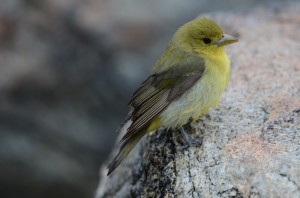A first rate vocalist is in residence at Hancock’s First Congregational Church. He is most often to be found early mornings (not just Sundays) perched atop the steeple, from where his melody can be heard the length and breadth of Main Street. The fellow’s name is Mimus polyglottus, better known to you and me as the Northern Mockingbird. Harper Lee recognized the beauty of his song, writing in To Kill a Mockingbird as Atticus instructs Jem, “I’d rather you shoot at tin cans in the backyard, but I know you’ll go after birds. Shoot all the blue jays you want, if you can hit ’em, but remember it’s a sin to kill a mockingbird.”
As the species scientific name suggests, the mockingbird’s song is not just beautiful but remarkable for its mimicry. Northern Mockingbirds are polyglots of the bird world. I sat outside the church last week with a recording device and listened as this particular individual sang perfect renditions of 17 different species of birds, from Killdeer to Scarlet Tanager. You can hear the recording at the following link.
http://soundcloud.com/eric-masterson/northern-mockingbird-hancock
Mimicry is a tool that mockingbirds use to develop their repertoire. Older mockingbirds have a larger catalogue of songs, which the females use as a measure of fitness. Mockingbirds may also use mimicry to defend food resources from other birds. When he sings the song of the Northern Cardinal, he may in effect be saying to nearby cardinals “take notice, I know you are there, and I will defend this blueberry bush if you come near”.
Much like my accent is a cue that I am from Ireland, you can tell where a mockingbird grew up by his song. I encountered an individual last summer singing from beach scrub in Portsmouth. He included snippets of song from many of the aforementioned birds, but also the calls of Greater Yellowlegs, a common shorebird along New Hampshire’s coast. A bird on Star Island this spring included Common Tern notes in his repertoire. Star Island is less than half a mile from one of the largest colonies of Common Terns in the Gulf of Maine. Our Hancock mockingbird would be unlikely to pick up the notes of either the yellowlegs or the tern. Unlikely but not impossible, as the following anecdote illustrates: a Northern Lapwing was photographed in Loudon back on March 10th. Lapwings are a European shorebird, extremely rare in the US, and this was the first ever record for New Hampshire.
Unfortunately it stayed for only one day, but a birder looking for it reported that a European Starling, another renowned mimic, was including the distinctive call of the lapwing in its song. If the bird had not been seen, its presence could have been inferred using a bit of forensic ornithology. Closer to Hancock, the recording of the church mockingbird includes some notes that are a match for Eurasian Linnet, a species that has never been recorded in the US to the best of my knowledge. I will wait for a sighting before claiming this one though!
If you are interested in learning more about the songs of mockingbirds and other species, consult Donald Kroodsma’s wonderful book The Singing Life of Birds.


No comments yet.